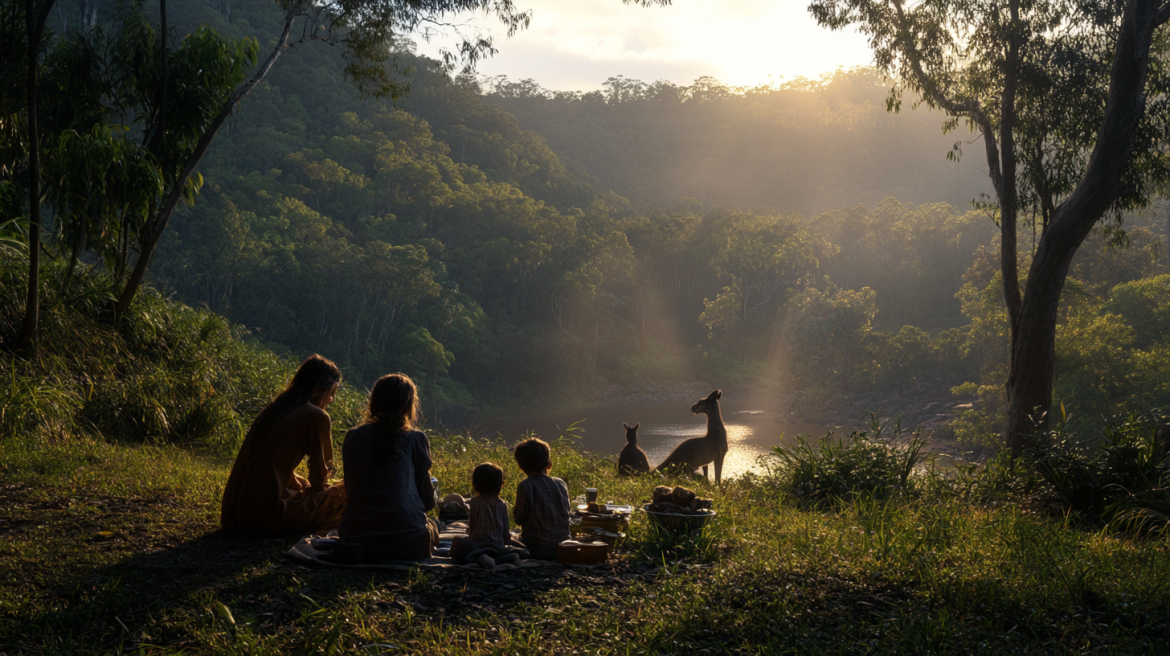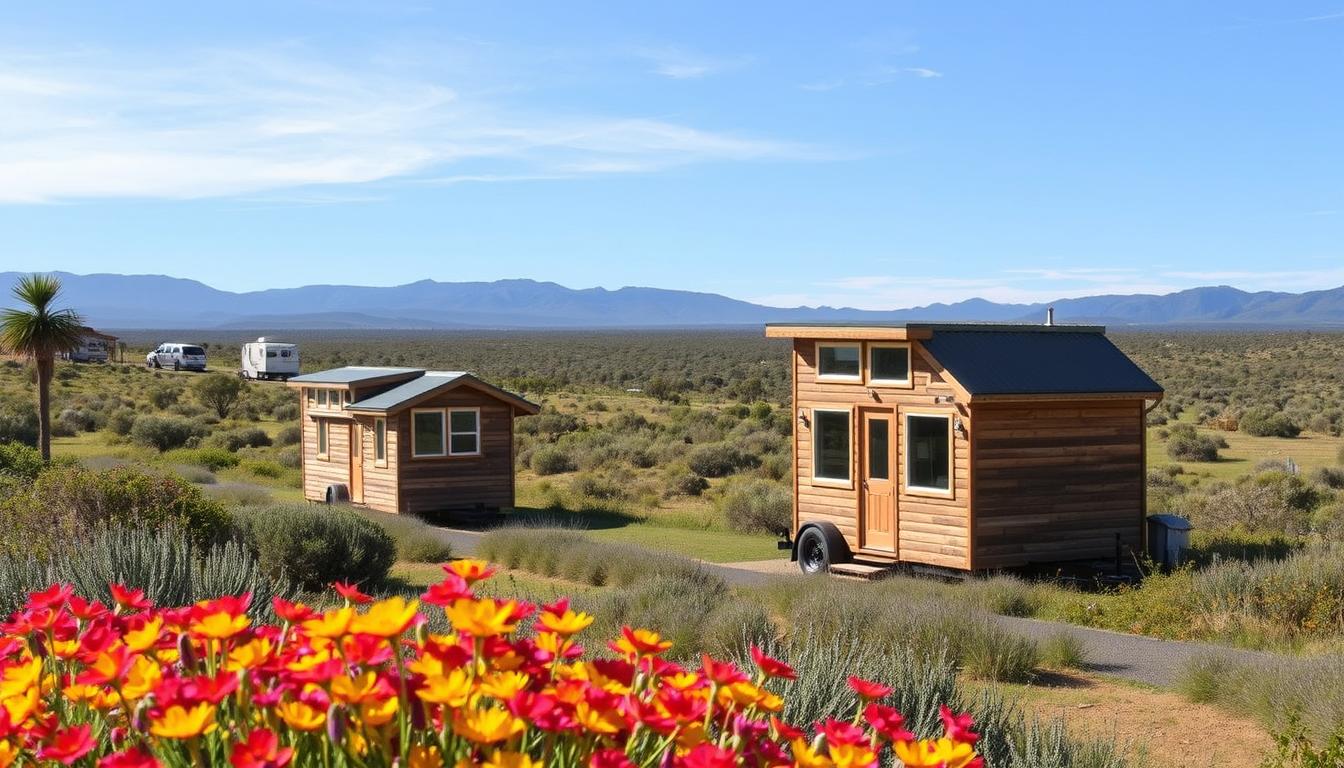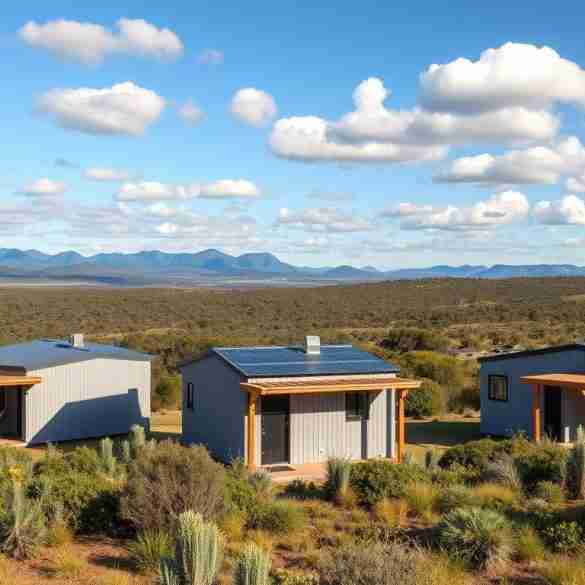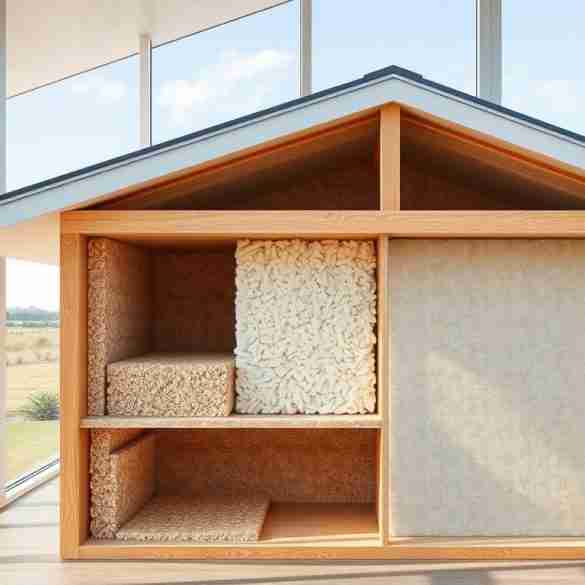Did you know eastern grey kangaroos live near humans in places like golf courses and homes? These animals are great at making new homes in places changed by humans. As cities grow, some animals leave their old homes. Others find new places to live, like our neighborhoods.
These animals see the city as their new wild place. It has everything they need to live. Even some animals that are rare can be found in the suburbs. But, we must be careful around them and know how to stay safe.
Queensland is full of animals that can be dangerous, like snakes and sharks. But, getting hurt by them is very rare. It’s important to know how to live safely with these animals.
This guide from Sustainable Home Magazine will inform you about living with wildlife in Queensland. You’ll learn about helping injured animals, making your yard safe for wildlife, and staying safe with dangerous animals. By understanding wildlife, we can live together peacefully in Queensland.
Key Takeaways about living with wildlife in Queensland
- Eastern grey kangaroos are highly adaptable to altered landscapes and can thrive in urban and suburban areas.
- As cities expand, some wildlife species move into new habitats, seeing them as the “new wild.”
- Queensland is home to potentially dangerous wildlife, but the risk of serious injury or death is extremely small.
- Creating a wildlife-friendly backyard can help support native species in urban environments.
- Understanding animal behaviors and practicing wildlife safety is key to coexisting harmoniously with Queensland’s wildlife.
Embrace the “New Wild” in Queensland’s Urban Areas
Urban areas in Queensland are growing, bringing new challenges and chances for wildlife. This “new wild” is where city and suburb wildlife learn to live together. By protecting their homes and supporting conservation, we can keep these places healthy and full of life.

Adapting Wildlife in Cities and Suburbs
Many animals are adapting to city life, finding new ways to survive and flourish. From possums in roofs to birds in street trees, they’re becoming common in Queensland’s cities. By adding native plants, water, and shelter in your yard, you can help these animals.
“The era of killing large animals out of fear and ignorance is now over, and our perception of these animals is becoming balanced with a better understanding that they aren’t ‘man-eating monsters’ but instead have a right to exist and an ecological role to play as top predators.”
Threatened Species in Your Neighborhood
Did you know threatened species might live near you? You can find out which ones by asking for a species list online. In Queensland’s cities, you might find:
- Koalas
- Powerful Owls
- Richmond Birdwing Butterflies
- Grey-headed Flying Foxes
Protecting their homes and supporting conservation can help these species thrive. Simple steps like planting native plants, keeping pets safe, and avoiding pesticides can make a big difference.
As we welcome the “new wild” in Queensland’s cities, staying updated on conservation efforts is key. Joining events and supporting groups like the Arkaba Conservancy can help protect our urban wildlife for the future.
Safety First: Handling Injured or Sick Wildlife
Meeting an injured, sick, or orphaned wild animal can be tough. But, it’s key to think about your safety and the animal’s well-being. In Queensland, laws protect all native animals. Only those with a license can handle them.
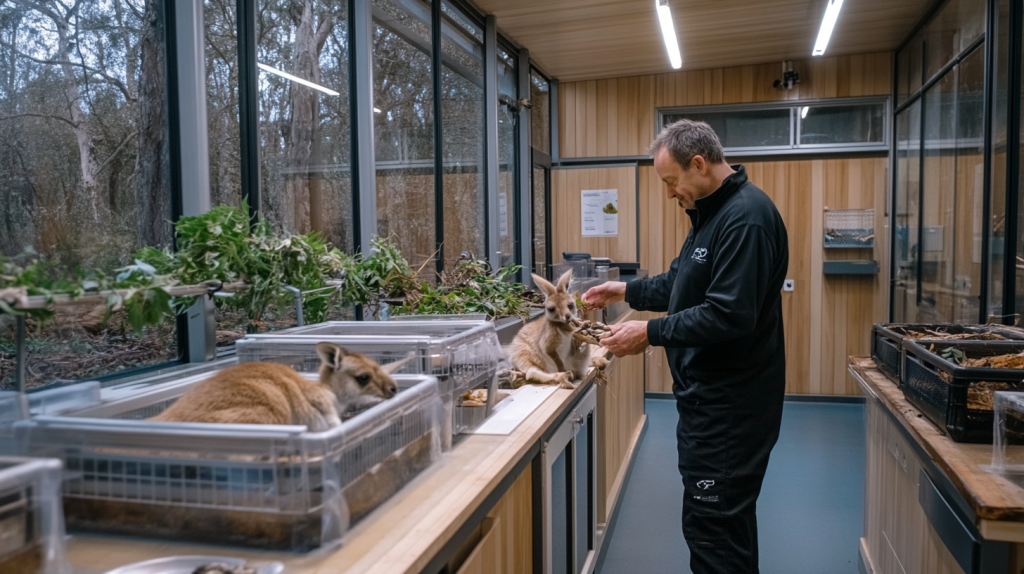
Assessing the Situation and Environment and living with wildlife in Queensland
Before helping an injured or sick animal, make sure it’s safe for you and the animal. Think about these things:
- Is the animal in danger, like on a busy road?
- Can you catch and handle the animal safely?
- Do you have the right gear, like gloves or a towel?
Remember, injured animals might defend themselves. So, be careful and use protective gear.
Proper Handling Techniques for Different Species
Each species needs its way of being handled to keep them safe. Here are some tips for handling wildlife in Queensland:
| Species | Handling Technique |
|---|---|
| Birds | Gently cover the bird with a towel and put it in a box with air holes. If you can’t find the nest, make a new one. |
| Marsupials | Cover the animal and put it in a safe box. If you find a dead mom with joeys, be careful and ask for help from a wildlife carer. |
| Echidnas | Use thick gloves and put echidnas in a safe box. Call a licensed echidna carer for help. |
| Snakes and Bats | Don’t touch snakes unless you know how. Never touch bats without a vaccine against Australian Bat Lyssavirus. Get help from experts. |
Keep the animal warm, quiet, and away from loud noises to help it survive. Don’t give it food or water, as it could hurt it more.
When to Call for Professional Help
It’s usually best to get help from wildlife experts or rescue groups. They know how to care for sick or injured animals. Here are times to call for help:
- If you’re not sure about the animal’s condition or how to handle it
- When dealing with venomous snakes, bats, or other dangerous animals
- If the animal needs medical care or special help
- When you see wildlife crimes or illegal animal activities
In Queensland, call the RSPCA’s 24/7 Animal Emergency Hotline at 1300 ANIMAL (1300 264 625) for advice and help. They can guide you and connect you with wildlife centers, vets, or licensed carers.
By being careful and getting help when needed, you help protect Queensland’s unique wildlife.
Creating a Wildlife-Friendly Backyard and living with wildlife in Queensland
Turning your backyard into a home for local wildlife helps support biodiversity and protect native species in Queensland. By adding important habitat elements and native plants, you make a space that helps animals and looks great. Here are some tips to make your backyard a haven for wildlife:

Providing Essential Habitat Elements and living with wildlife in Queensland
To draw and support many kinds of wildlife, add these key elements to your backyard:
- Water sources: Put in bird baths, make a frog or fish pond, or use shallow dishes for small animals.
- Food: Plant native plants that give nectar, seeds, fruits, or leaves for wildlife to eat.
- Shelter: Use mulch, old wood, logs, or nest boxes for birds, possums, and gliders.
Adding these to your garden makes a place where many species can live well.
Planting Native Species for Food and Shelter
Using native plants in your backyard is a great way to help local wildlife. These plants fit the local weather and soil, needing less water and care. They also give food and shelter to native animals, insects, and birds. Think about these when picking plants for your garden:
- Look up native plants for your area by contacting your local council or visiting the Birds in Backyards website.
- Pick a mix of plants with different foods, like nectar flowers, seed grasses, and fruit trees.
- Plant groundcovers, shrubs, and trees to make layers in your garden, offering shelter and places to nest.
Logan ratepayers can get three free trees each year through the Free Trees program. For info on native plants, email [email protected].
Adding native plants makes your garden beautiful and helps the environment. It also helps protect local wildlife and increase your area’s biodiversity.
| Habitat Element | Importance | Examples |
|---|---|---|
| Water | Essential for hydration and cooling | Bird baths, frog ponds, shallow dishes |
| Food | Provides energy and nutrients | Native plants with nectar, seeds, fruits, or leaves |
| Shelter | Offers protection and nesting sites | Mulch, old timber, logs, nest boxes |
Creating a wildlife-friendly backyard is a long-term project. By always improving and caring for your garden, you’ll enjoy nature’s beauty. You’ll also help protect Queensland’s unique wildlife.
Coexisting with Common Queensland Wildlife
Queenslanders are lucky to live with many native animals. By learning about and respecting them, we can live together well. This section talks about common Queensland wildlife encounters and how to deal with them.
Possums: Nesting and Dermatitis
Possums are cute marsupials that might nest in our homes. If this happens, think about making your home possum-proof or building a box for them. But remember, possums are protected, so moving them is best done by experts.
If you see possums with skin problems, they might have dermatitis. This can come from stress or bad food. For help, talk to a wildlife vet or a rescue group.
Birds: Baby Birds, Swooping Magpies, and Shearwaters

You might find baby birds that seem lost during breeding season. Watch them first. Often, the parents are around and will take care of their babies. Use bird guides to figure out what to do next.
Magpies and plovers can swoop when they’re nesting. To avoid getting swooped, stay away from their nests, wear a hat, or carry an umbrella. These birds are just protecting their babies.
Shearwater birds, or mutton birds, sometimes land on beaches in big groups. If you see one in trouble, call a wildlife rescue group. They know how to help.
| Wildlife | Situation | Action |
|---|---|---|
| Possums | Nesting in roof or gutters | Consult a wildlife veterinarian or rescue organization |
| Possums | Sores on faces (dermatitis) | Observe the situation, consult bird identification resources |
| Baby birds | Fallen from nest | Avoid the nesting area, wear hat or carry an umbrella, and remain calm |
| Magpies and plovers | Swooping during nesting season | Avoid the nesting area, wear a hat or carry an umbrella, and remain calm |
| Shearwater birds | Found on beaches, in distress | Contact wildlife rescue organization for assistance |
Learning about Queensland’s wildlife through wildlife education programs helps us all. It teaches us how to be responsible and avoid conflicts. We live with these amazing animals, and it’s our job to live together well.
Living with Wildlife in Queensland: Staying Safe Around Potentially Dangerous Animals
Queensland is full of amazing wildlife, but it also has dangerous animals. Knowing the risks and how to live with them safely helps. This way, you can avoid conflicts with wildlife and help protect the environment.
Venomous Snakes and Spiders
Queensland has many venomous snakes, like the coastal taipan. Before 1956, this snake was always deadly. Now, snake bites are rare, causing almost no deaths each year. Always leave snakes alone and get help right away if bitten.
Queensland also has dangerous spiders like the redback and funnel-web. Spider bites are rare and usually not deadly. If you think you’ve been bitten, use a pressure bandage and get medical help fast.
Marine Life: Jellyfish, Stingrays, and Sharks
Queensland’s beaches have many dangerous sea creatures. Box jellyfish can be deadly, causing over 70 deaths in Australia since 1880. To avoid getting stung, swim in areas with nets during jellyfish season and wear protective clothes.
Stingrays and cone shell snails can hurt you too. The cone shell snail, found in the Great Barrier Reef, has killed over 30 people. Be careful and don’t touch sea creatures when you’re in the water.
Sharks, like tiger sharks, live in Queensland’s waters all year. But shark attacks are very rare, happening less than once a year in Australia. To avoid sharks, swim where lifeguards are on duty, and don’t swim at dawn, dusk, or night. Stay away from schools of fish too.
Estuarine Crocodiles: Understanding the Risks
Estuarine crocodiles, or saltwater crocodiles, live in Queensland’s coastal areas and can be up to 5 meters long. Most crocodile attacks happen because of risky behavior by people. To stay safe, follow these rules:
- Heed warning signs and keep away from crocodile areas
- Avoid swimming or wading where crocodiles live
- Be careful when fishing or boating, and don’t stand at the water’s edge
- Never bother, tease, or feed crocodiles
Meeting dangerous animals is still pretty rare. For example, in 2007, 359 people died in road accidents in Queensland. Since 1985, only seven people have died from crocodile attacks. By knowing the risks and following safety tips, you can live safely with dangerous animals in Queensland.
Educating Yourself and Others about Queensland’s Wildlife

Queensland’s wildlife is a treasure we should protect. Learning about local species helps us manage and conserve them. It also makes us appreciate the animals in our cities more.
Wildlife education programs are a great way to learn. Places like the Currumbin Wildlife Sanctuary and the Wildlife Habitat offer chances to meet native animals. Experts there teach us about their lives and why we should care for them.
Did you know that the Currumbin Wildlife Sanctuary has been aiding and educating visitors for almost 70 years, taking in thousands of sick or injured animals annually?
Telling others what you’ve learned is key. Sharing about wildlife’s needs can inspire others to care more. This helps with community efforts to live with wildlife in harmony.
| Wildlife Education OpportunityKey Features | |
|---|---|
| Crocodile Safari in Airlie Beach | In operation since 2000, offering a quality ecotourism experience with expert guides |
| Currumbin Wildlife Sanctuary | Aiding and educating visitors for almost 70 years, taking in thousands of sick or injured animals annually |
| Wildlife Habitat in Port Douglas | Rescues and releases hundreds of sick or injured animals yearly, allowing visitors to participate in wildlife care behind-the-scenes |
Every person can help Queensland’s wildlife. By learning and sharing what you know, you make a difference. Be a wildlife ambassador and help make a better future for Queensland’s animals.
Supporting Wildlife Conservation Efforts in Queensland
Living in Queensland gives you a chance to help protect our unique wildlife. By joining conservation efforts, you help keep our biodiversity safe. This is key for protecting endangered species.
Reporting Injured or Orphaned Animals
If you find an injured or orphaned wild animal, tell the right people. In Queensland, groups like the RSPCA and local carers can help. This quick action can save the animal’s life.
Always keep a safe distance and don’t touch the animal. This keeps it safe from more harm.
Volunteering with Local Wildlife Organizations
Helping out with local wildlife groups is a great way to make a difference. The Wildlife Preservation Society of Queensland has been working for over 60 years. They push for better environmental laws and work on the ground to save animals and their homes.
By volunteering, you can help rescue, heal, and release native animals back into the wild.
| Organization | Years of Operation | Donation Allocation |
|---|---|---|
| Wildlife Preservation Society of Queensland | 60+ | Over 70% towards conservation projects |
Promoting Responsible Ecotourism Practices
Queensland is known for its diverse wildlife and ecosystems, attracting many tourists. You can help by promoting responsible tourism. This means watching animals from afar, not feeding them, and throwing away trash properly.
By being a good example and teaching others, you can build a culture that respects our wildlife.
“Approximately 50% of Brisbane’s wildlife habitat is located on privately-owned land, making the involvement of residents crucial for effective wildlife conservation.”
Donating to groups like Wildlife Queensland also helps a lot. They use over 70% of donations for projects to save species and their homes. For example, they work to protect the spotted-tailed quoll, which has less than 10,000 left in the wild.
By joining wildlife conservation efforts, you protect Queensland’s unique animals for the future. This way, future generations can also enjoy and live with these amazing creatures.
Dealing with Wildlife Encounters During Natural Disasters
Natural disasters like floods are dangerous for humans, pets, and wildlife. When floodwaters rise, animals move more and may enter new areas. It’s important to know how to handle these situations to keep everyone safe.
Increased Mobility and Distribution of Animals During Floods
During floods, animals face big challenges as they look for higher ground. This can lead to more human-wildlife conflict. Here are some tips:
- Be aware that native species like snakes and crocodiles may be in new areas due to floodwaters.
- Keep your pets’ tags and microchips updated for easier tracking.
- If you find distressed wildlife, get advice from trained rescuers or vets.
- Have a plan for your animals in emergencies to help them feel safe.
Reporting Crocodile Sightings and Snake Removals
In Queensland, report crocodile sightings to the CrocWatch hotline at 1300 130 372. The department looks into all reports and acts if needed. For snakes, call private snake catchers authorized under the Nature Conservation Act 1992 for safe removal.
Always put your safety first in emergency situations with wildlife during floods. Seek help from experts when needed.
Here’s how to be ready for wildlife during disasters:
| State | Emergency Contact | Services Provided |
|---|---|---|
| New South Wales | Local Land Services: 1300 795 299 | Emergency support for managing livestock or flood impacts |
| Queensland | Business Queensland | Advice and contact numbers for preparing animals for natural disasters |
| Various States | Wildlife Helplines | Quick assistance for wildlife rescue and rehabilitation |
By being informed and prepared, you help protect our wildlife biodiversity. This also helps us live in harmony with native species in Queensland.
Final Thoughts about living with wildlife in Queensland
Living with wildlife in Queensland lets you enjoy nature and be responsible. You can help protect the environment by making your backyard safe for native animals. This balance is key to living with animals in our cities.
You can help by learning and getting others to care about nature. Supporting local groups and helping animals in need makes a big difference. Every small action helps protect our wildlife.
When you live with nature in Queensland, always keep safety first. Learn how to handle different animals safely and know when to get help. Together, we can live in harmony with wildlife, keeping Queensland’s nature beautiful for the future.
For more tips on living sustainably and helping wildlife, visit Sustainable Home Magazine at https://sustainablehomemag.com. Let’s work together to make a better world for us and the amazing animals of Queensland.

